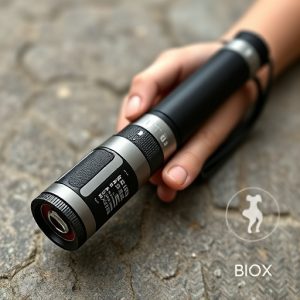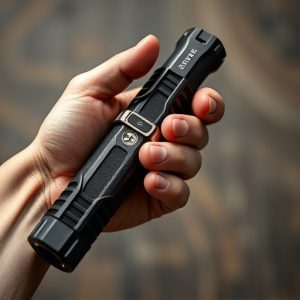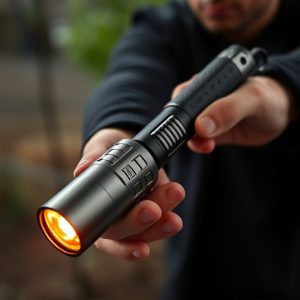Mastering Self-Defense with Expandable Batons: A Guide to Riot Control Equipment Legality and Use
Self-defense expandable batons are a key non-lethal tool for law enforcement, used during public di…….
Self-defense expandable batons are a key non-lethal tool for law enforcement, used during public disturbances and riot control to manage large crowds or confront individuals who pose a threat. These devices are designed for discreet carry, quick deployment, and offer a balance between reach and control, allowing officers to maintain authority at a distance while retaining controllability in close range encounters. They are employed as a last resort after attempts at de-escalation have failed and require proper training for effective and ethical use, understanding their limitations, potential for injury, and legal implications. Expandable batons offer a compact yet effective self-defense solution with quick retractability, facilitating a transition from confrontational to non-aggressive interactions. They are subject to strict regulations and are integral to maintaining public order and respecting human rights. These batons serve as a testament to advanced mechanical engineering, ensuring structural integrity, safety through secure locking mechanisms, and ergonomic handling for personal protection in various situations. Law enforcement personnel receive specialized training to use them within the scope of the law, emphasizing legal usage variations across jurisdictions and the importance of proportionate force in self-defense scenarios.
When public order disruptions arise, law enforcement faces the critical task of maintaining safety and stability. A pivotal tool in this high-stakes scenario is the self-defense expandable baton, a versatile piece of riot control equipment designed to manage volatile situations effectively. This article delves into the multifaceted role of these batons, evaluating their legal frameworks, mechanical design, and optimal deployment strategies. From understanding their purpose to mastering their use, this exploration will illuminate key aspects of employing expandable batons in riot control scenarios, ensuring both officer safety and public security.
Understanding Riot Control: The Role of Self-Defense Expandable Batons
When public order is disrupted and law enforcement faces challenging situations, self-defense expandable batons serve as a critical tool in maintaining control and ensuring the safety of both officers and bystanders. These collapsible batons offer a non-lethal option for police to manage large, unruly crowds or individuals posing a threat without resorting to more severe measures. Their design allows them to be compact when stored but quickly extendable to an effective length for defensive maneuvers. The efficacy of self-defense expandable batons lies in their balance of reach and control; they provide officers with a means to assert authority from a safe distance while still being manageable for close encounters.
The deployment of expandable batons is governed by strict protocols that dictate their use as a last resort, emphasizing the importance of de-escalation and proportional response in law enforcement. Training is paramount in ensuring that officers are proficient in the proper application of these batons, which includes understanding their limitations and the potential for injury when used improperly. This training also covers legal implications and ethical considerations, reinforcing the principle that such equipment should only be used when necessary to protect life or prevent serious damage to property. The self-defense expandable baton, therefore, is not merely a piece of riot control equipment but a tool embodying the delicate balance between maintaining order and upholding human rights.
Key Components of Effective Riot Control Equipment: A Focus on Expandable Batons
Riot control equipment encompasses a range of tools designed to maintain order and protect both law enforcement personnel and the public during civil unrest. A critical component within this arsenal is the expandable baton, often considered a staple in self-defense for officers due to its versatility and effectiveness. The design of an expandable baton allows for a compact form that can be easily carried while on duty, yet when extended, it becomes a formidable weapon capable of deterring aggressors and incapacitating them if necessary.
The efficacy of an expandable baton lies in its balance of control and force application. When deployed, it extends to a length that maximizes reach and impact without requiring significant physical strength from the user. This feature is particularly valuable in situations where officers must manage multiple threats simultaneously or when facing individuals resistant to verbal de-escalation tactics. The baton’s capacity to deliver controlled blows at a safe distance can prevent injuries to both the officer and the subject, making it an indispensable tool in conflict resolution. Additionally, its ability to be quickly retracted allows for a swift transition from confrontational engagement back to non-aggressive interaction, should the situation de-escalate or require alternative methods of control. The expandable baton is a testament to the innovation in riot control equipment, providing law enforcement with a reliable self-defense tool that upholds public safety while respecting individual rights.
Evalubing the Legal Implications and Proper Use of Expandable Batons in Self-Defense Scenarios
When considering the legal implications of using an expandable baton for self-defense, it’s crucial to understand the laws that govern defensive weapons in your jurisdiction. Expandable batons are designed as a non-lethal self-defense tool, offering a balance between reach and control in confrontational situations. The effectiveness of these batons is rooted in their versatility; they compactly fit into a pocket or purse yet extend to a length capable of deterring an aggressor at a safe distance. Users must familiarize themselves with local regulations as laws differ by state, country, and city. In many regions, the use of such devices is restricted or requires specific permissions; therefore, potential owners should verify legal parameters before purchase and acquisition.
Proper use of an expandable baton in self-defense scenarios demands training to ensure it’s wielded responsibly. The training encompasses understanding the baton’s mechanics, learning the appropriate techniques for deployment, and practicing strikes with precision to incapacitate without causing disproportionate harm. Ethical use is akin to striking an attacker in areas where blows are less likely to result in severe injury, such as the arms or legs. It’s imperative to avoid unnecessary force, as self-defense laws often scrutinize whether the response was proportionate to the threat faced. The key lies in maintaining control over the situation and using the baton solely for defense, never as a preemptive strike or in retaliation. Users must also consider the potential consequences of brandishing or deploying the baton, as this can escalate the situation and lead to legal complications if not justified by an imminent threat. Consequently, the proper use of an expandable baton is a blend of knowledge, skill, and situational awareness, all within the confines of the law.
The Mechanism and Design Behind Self-Defense Expandable Batons: Ensuring Safety and Efficiency
Self-defense expandable batons represent a sophisticated blend of mechanical engineering and tactical design, serving as an essential tool for law enforcement officers and individuals seeking personal protection. The mechanism at the heart of this device allows it to be compact yet capable of rapid extension into a longer, more effective weapon. This feature is particularly advantageous in situations where space is limited or when the need for deployment arises swiftly. The design incorporates a series of internal locking mechanisms and a high-strength polymer construction that ensures the baton’s integrity both in its retracted and extended states. When fully extended, the baton provides a significant length advantage, enabling users to deliver strikes from a safer distance, reducing the risk of close-range confrontations. The efficiency of this self-defense tool is further enhanced by its ergonomic grip and balanced design, which facilitates precise handling and control, even under the stress of an altercation. Safety features are integral to the baton’s design; it is engineered to lock securely into both positions, thereby preventing accidental deployment or retraction, and reducing the likelihood of injury to the user or bystanders. The self defense expandable baton’s effectiveness lies in its ability to balance the need for non-lethal force with the necessity for a reliable and easy-to-use self-defense weapon.
Training and Best Practices for Deploying Expandable Batons in Riot Control Situations
When deploying expandable batons in riot control situations, it is imperative that law enforcement personnel receive comprehensive training to effectively use these tools as a means of self defense. This specialized training encompasses not only the technical handling and deployment of the baton but also the legal implications, use-of-force guidelines, and de-escalation techniques that are crucial for maintaining public order. Best practices dictate that officers should be proficient in various scenarios, understanding the potential force necessary to neutralize a threat without causing unnecessary harm. The expandable baton, as a self defense tool, is designed to offer a balance between control and effectiveness, allowing officers to respond appropriately to aggressive behavior while minimizing injury to both the subject and bystanders. Training should include realistic drills that simulate crowd dynamics, emphasizing the importance of situational awareness and decision-making under pressure. By adhering to these training protocols and best practices, law enforcement agencies can ensure that expandable batons are used responsibly and effectively within the context of riot control.


